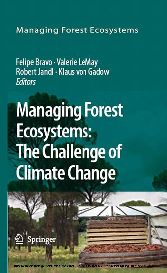Suche
Lesesoftware
Info / Kontakt
Managing Forest Ecosystems: The Challenge of Climate Change
von: Felipe Bravo, Valerie LeMay, Robert Jandl, Klaus von Gadow
Springer-Verlag, 2008
ISBN: 9781402083433 , 333 Seiten
Format: PDF, Online Lesen
Kopierschutz: Wasserzeichen




Preis: 149,79 EUR
eBook anfordern 
Foreword
6
Contents
8
Part I Introduction
11
Introduction
12
1 Forest Management and Climate Change
12
2 Mitigation Through Adaptive Forest Management
14
3 Monitoring and Adaptive Management
15
4 Research
16
5 Organization of This Book
17
References
18
Part II Overview of Climate Change and Forest Responses
21
A Mechanistic View of the Capacity of Forests to Cope with Climate Change
22
1 Introduction
22
2 The Complexity of Climate Change and of Its Effects
24
3 Climate Change and Tree Physiology
29
4 Climate Change, Phenotypic Plasticity and Rapid Evolution
35
5 Scaling Up to the Community: Species Interactions
37
6 The Challenge of Modelling Distribution Responses to Climate Change
39
7 The Case of Mediterranean Forests
40
8 Concluding Remarks
41
References
42
Greenhouse-gas Emissions from Temperate Mountain Forests
48
1 Introduction
48
2 Carbon and Nitrogen Pools in Mountain Forests
51
3 Net Ecosystem CO2 and H2O Exchange in High Elevation Forests
53
4 Seasonal Dynamics
55
5 System Dynamics
61
6 Conclusions
62
References
63
Part III Monitoring and Modeling
68
Estimating Carbon Stocks and Stock Changes in Forests: Linking Models and Data Across Scales
69
1 Introduction
69
2 Monitoring Challenges
70
3 Integrating Multiple Data Sources Across Spatial Scales
76
4 Integrating Multiple Data Sources Across Time Scales
82
5 Concluding Remarks and Research Needs
83
References
84
Forest Eco-physiological Models and Carbon Sequestration
88
1 Introduction
88
2 GOTILWA+ : A Process-Based Model
92
3 Model Applications
95
4 The Future of Eco-physiological Models
104
5 Conclusion
105
References
106
Influence of Climatic Variables on Crown Condition in Pine Forests of Northern Spain
108
1 Introduction
108
2 Materials and Methods
110
3 Results
112
4 Discussion
116
References
118
Part IV Economic and Management Impacts
121
Influence of Carbon Sequestration in an Optimal Set of Coppice Rotations for Eucalyptus Plantations
122
1 Introduction
122
2 Materials and Methods
124
3 Results and Discussion
131
4 Conclusions
135
References
135
Use of Forests and Wood Products to Mitigate Climate Change
139
1 Introduction
139
2 Case Studies
141
3 Discussion
148
References
150
Biomass Forest in Sweden and Carbon Emissions Balance
152
1 Introduction
152
2 Biomass Production
155
3 Biomass and the Carbon Emission
157
4 Conclusions
162
References
163
Taper Equations and Wood Products: Assessing the Carbon Flow of the Forest Through Its Products
165
1 Introduction
165
2 Estimation of Carbon Stocks
166
3 Materials and Methods
168
4 Results and Discussion
171
5 Conclusions
176
References
176
Forest Management Strategies and Carbon Sequestration
178
1 Introduction
178
2 Forest Management and Carbon Sequestration During the Last Century
180
3 Strategies to Improve Carbon Sequestration
182
4 Conclusions
190
References
191
Analysing the Effects of Forest Structure on Carbon Stocks and Timber Production Under Changing Management and Climate
194
1 Introduction
194
2 Material and Methods
196
3 Results
202
4 Discussion
210
5 Conclusions
214
References
214
Part V Case Studies
218
Carbon Sequestration in Mediterranean Pine Forests
219
1 Introduction
219
2 Carbon Stocks over Time for Two Scots Pine Forests
221
3 Management Alternatives and CO2 Fixation in Mediterranean Maritime Pine
226
4 Carbon Sequestration in Even and Uneven Aged Stone Pine Stands
230
5 Modelling Coarse Woody Debris in Pine Plantations
234
6 Conclusions
239
References
240
Carbon Sequestration of Ponderosa Pine Plantations in Northwestern Patagonia
244
1 Introduction
244
2 Geographical Context
245
3 Forest Lands and Site Quality
247
4 Baseline
247
5 Stand Growth, Biomass, and Carbon Estimates
249
6 Regional Scenarios of Carbon Sequestration
253
7 Conclusions
260
References
261
Assessing Pine Wilt Disease Risk Under a Climate Change Scenario in Northwestern Spain
265
1 Introduction
265
2 Material and Methods
267
3 Results and Discussion
269
References
277
Dynamics of Soil Carbon in Primary and Secondary Tropical Forests in Colombia
279
1 Introduction
279
2 Materials and Methods
281
3 Results and Discussion
285
4 Conclusions
289
References
290
Carbon Sequestration Potential of Mangroves in Southeast Asia
293
1 Introduction
293
2 Distribution and Abundance
294
3 Mangrove Forest Destruction
297
4 Services and Functions Provided by Mangroves
298
5 Carbon Sequestration in Mangrove Forests
300
6 Conclusions
306
References
306
Silviculture and Carbon Sequestration in Mediterranean Oak Forests
312
1 Introduction
312
2 Biomass Production and Carbon Sequestration in Spanish Cork Oak Forests
313
3 Biomass Production and Carbon Sequestration in Portuguese Cork Oak Forests
319
4 Carbon Quantification in Pure Quercus pyrenaica Willd. Woodlands in Spain
324
5 Carbon Quantification in Pure and Mixed Stands in Central Spain
327
6 Final Remarks
331
References
332





